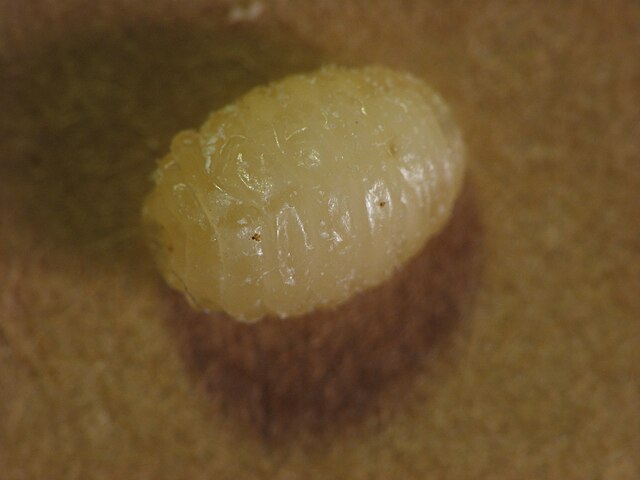Loading AI tools
Juvenile form of distinct animals before metamorphosis From Wikipedia, the free encyclopedia
A larva (/ˈlɑːrvə/; pl.: larvae /ˈlɑːrviː/) is a distinct juvenile form many animals undergo before metamorphosis into their next life stage. Animals with indirect development such as insects, some arachnids, amphibians, or cnidarians typically have a larval phase of their life cycle.

A larva's appearance is generally very different from the adult form (e.g. caterpillars and butterflies) including different unique structures and organs that do not occur in the adult form. Their diet may also be considerably different. In the case of smaller primitive arachnids, the larval stage differs by having three instead of four pairs of legs.[1]
Larvae are frequently adapted to different environments than adults. For example, some larvae such as tadpoles live almost exclusively in aquatic environments, but can live outside water as adult frogs. By living in a distinct environment, larvae may be given shelter from predators and reduce competition for resources with the adult population.
Animals in the larval stage will consume food to fuel their transition into the adult form. In some organisms like polychaetes and barnacles, adults are immobile but their larvae are mobile, and use their mobile larval form to distribute themselves.[2][3] These larvae used for dispersal are either planktotrophic (feeding) or lecithotrophic (non-feeding).
Some larvae are dependent on adults to feed them. In many eusocial Hymenoptera species, the larvae are fed by female workers. In Ropalidia marginata (a paper wasp) the males are also capable of feeding larvae but they are much less efficient, spending more time and getting less food to the larvae.[4]
The larvae of some organisms (for example, some newts) can become pubescent and do not develop further into the adult form. This is a type of neoteny.[5]

It is a misunderstanding that the larval form always reflects the group's evolutionary history. This could be the case, but often the larval stage has evolved secondarily, as in insects.[6][7] In these cases[clarification needed], the larval form may differ more than the adult form from the group's common origins.[8]


Within Insects, only Endopterygotes show complete metamorphosis, including a distinct larval stage.[10][11] Several classifications have been suggested by many entomologists,[12][13] and following classification is based on Antonio Berlese classification in 1913. There are four main types of endopterygote larvae types:[14][15]
Seamless Wikipedia browsing. On steroids.
Every time you click a link to Wikipedia, Wiktionary or Wikiquote in your browser's search results, it will show the modern Wikiwand interface.
Wikiwand extension is a five stars, simple, with minimum permission required to keep your browsing private, safe and transparent.